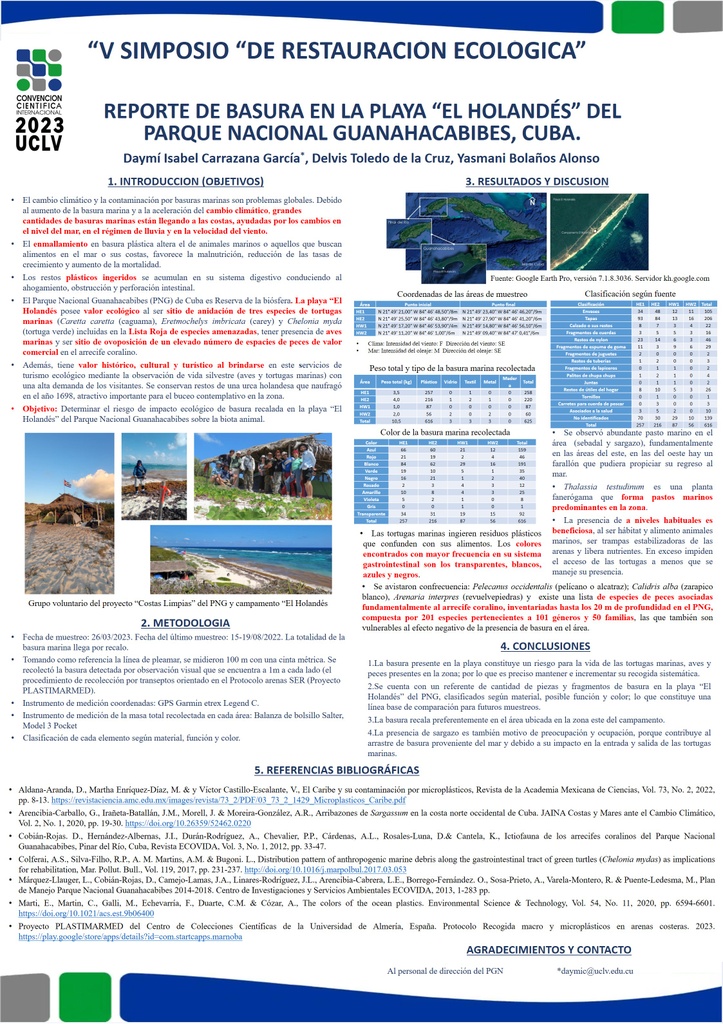Executive Secretary

IX Conferencia Científica Internacional sobre Desarrollo Agropecuario y Sostenibilidad
V Simposio de Restauración ecológica

Resumen
El Caribe es el segundo mar más contaminado por basura del mundo. Los residuos urbanos de esta región van a basureros a cielo abierto y el 85% de sus aguas residuales no son tratadas, arribando gran parte de estas a las playas. Por otro lado, el Parque Nacional Guanahacabibes de Cuba es Reserva de la Biosfera y las tortugas marinas que anidan en sus playas están en la Lista Roja de especies amenazadas. Los objetivos del trabajo fueron cuantificar y clasificar la basura de la playa “El Holandés”, de modo se puedan realizar comparaciones entre áreas. Además, predeterminar el impacto ambiental del plástico. El material se recolectó, cuantificó y clasificó por tipología, posible origen y color. Además, se fotografiaron otras incidencias. Las áreas al este del campamento están más contaminadas con residuos marinos. El material predominante es el plástico (fundamentalmente tapas y envases); el número de fragmentos cuya función no puede ser identificada es grande. Predominaron los colores blanco y azul. El material plástico pudiera ser ingerido por tortugas marinas, aves y peces al ser confundidos con alimentos u obstaculizar su comportamiento normal. La presencia de sargazo en grandes cantidades impactaría negativamente en la entrada y salida de las tortugas y su anidación y es una fuente de entrada de basuras marinas. Se cuenta con una línea base para un estudio longitudinal y se corrobora la importancia de realizar la recogida sistemática de la basura.
Abstract
The Caribbean is the second most polluted sea by debris in the world. Urban waste from this region goes to open dumps and 85% of its wastewater is not treated, arriving a large part of these to the beaches. The Guanahacabibes National Park is Biosphere Reserve and the sea turtles that nest on its beaches are on the Red List of threatened species.The objectives of the work were quantify and classify the waste from the beach "El Holandés", so that comparisons can be made between areas. Also, predetermining the environmental impact of plastic. A collection was made classifying and counting by type of material, possible origin and color. In addition, other incidents were photographed. The areas to the east of the camp are more contaminated with the presence of marine debris. The predominant material is plastic (fundamentally lids and containers); the number of fragments whose function cannot be identified is large. The white and blue colors predominated. The plastic material could be ingested by sea turtles, birds and fish by being confused with food or hindering their normal behavior. The presence of sargassum in large quantities would negatively impact the entry and exit of turtles and their nesting, and it is a source of entry of marine debris.There is a baseline for a longitudinal study and the importance of carrying out the systematic collection of garbage is corroborated.
Sobre el ponente

Daymí Isabel Carrazana García

Graduado de Licenciada en Ciencias Farmacéuticas, 1990: Universidad Central “Marta Abreu de Las Villas, (UCLV), Cuba. Ingeniera Agrónoma, 2007: UCLV, Cuba. Master en Ciencia y Tecnología de los Procesos Biotecnológicos (1998). Doctora en Ciencias Agrícolas (2008).
Institución en la que labora: UCLV (1991-2025). Profesora Titular. Departamento de Farmacia.
Experiencia docente: Profesora de Microbiología y Biotecnología en las carreras de Licenciatura en Ciencias Farmacéuticas (1991-2025) y Licenciatura en Biología (2006-2014). Tutora de 40 Trabajos de Diploma en ambas carreras. Profesora de Riesgo y Gestión Ambiental, Biotecnología Farmacéutica, Biotecnología Vegetal y Microbiología aplicada en las Maestrías Desarrollo de medicamentos, Práctica Farmacéutica, Ingeniería Ambiental y Agricultura sostenible. Líneas de investigación más importantes en las que ha participado: Contaminantes microbianos en el cultivo de tejidos vegetales; Impacto ambiental y sobre la salud humana de los agentes biológicos causantes de biodeterioro; Análisis de riesgo de residuos de químicos en el ambiente; Contaminación ambiental por residuos sólidos (plásticos); Educación ambiental.
Discussion

